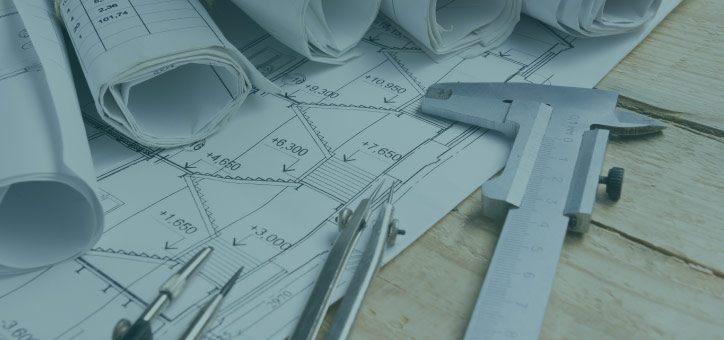Civil engineering refers to the building of structures or systems in the natural environment. Typical civil engineering projects include:
- roads
- bridges
- airports
- dams
- sewers and other pipelines
- electrical grids
Before starting construction, professional engineers use land surveying to determine the exact parameters of the natural environment. Surveying in civil engineering is taking and using measurements of the earth’s surface to be used in:
- planning
- recording
- future purposes
What Is the Definition of Surveying in Civil Engineering?
You may be wondering about the fundamentals of surveying in civil engineering. In the context of civil engineering, surveying refers to the gathering of various data about the land. Civil engineering land surveying typically involves measurements of horizontal and vertical distances between points. It also includes descriptions of the exact characteristics of the land structure and surface.
A boundary survey is used to detail the boundaries of a property. Since accurate measurements are necessary it is best done by a professional surveyor.
What Role Does Surveying Play in Civil Engineering?
Surveys are used to plan, build, and maintain all civil engineering projects. A full survey of the target area is usually necessary to determine its exact boundaries and to ensure that any buildings or other structures constructed there will be safe. A surveying engineer also works to:
- provide the proper design and development of infrastructure
- protect the surrounding natural environment
- maximize the efficiency of the proposed structures
What Types of Surveying in Civil Engineering Are Used?
There are a few types of civil engineering surveys: plane surveying and geodetic surveying. In plane surveying, the surveyor treats the area as a level geometric plane. They ignore the curvature of the earth. This works best for a project that is less than 250 km 2.
Geodetic surveying, on the other hand, considers the earth as a sphere. Surveyors use this category of survey only for very large projects. Most geodetic surveys are completed by government agencies for major infrastructure projects within their boundaries. This includes canals and pipelines.
The focus affects the type of survey. For instance, if a surveyor is hired to provide surveys for a dam, they would often conduct both topographical (land) and hydrographic (water) surveys for the project. They may also revisit the survey of the dam after its construction to ensure that it:
- matches the plans
- fits in the map boundaries
- remains safe
This is called an “as-built” survey.

The most common survey in civil engineering is the topographic survey. Topographic (land) surveyors focus on the qualities of the land itself. This may involve:
- gathering data on the distance and angles between key points
- the measurement of relative elevations
- the nature of the land (rocky, forested, grassy, etc.)
Topographic surveys may include data on both natural features (hills, rivers, etc.) and human construction (roads, power lines, etc.). A property surveyor or land surveyor may also use topographic surveys to make maps.
Why Is As-Built Surveying Important for Civil Engineers?
The job of a civil engineer continues even after construction is finished. Surveying and engineering are important parts of project management. Each project requires a new survey upon completion to establish the accuracy of the data used. For instance, to check that the known measurements (made earlier) match the positions and other details of the final project, an as-built survey is conducted. Structures must be surveyed repeatedly to determine their technical performance as well as to ensure that they can still perform safely and are still in the right position.
What is Surveying Engineering?
Surveying engineering is an area within civil engineering that determines land boundaries or locations with bodies of water using maps and reports. Surveying engineers may work for:
- surveying services
- construction companies
- government agencies
Geographic Information System (GIS) is software used to make a 3D image of land or a body of water. Data will be collected at the site using this tool.
Remote sensing uses electricity, sunshine, and other artificial light sources to gather data without touching the area. It may be used in:
- urban projects
- sanitation
- new roads
A surveying engineer uses innovative equipment such as :
- Global Positioning Systems (GPS)
- satellite imagery
- electronic theodolites
- levels
- aerial photographs
The average salary of a civil engineer is $88,050. Depending on the industry, the average salary can be even higher. For example, working for the Federal Executive Branch.
Is a Licensed Surveyor Different from a Licensed Engineer for Civil Engineering and Surveying?
Yes. You can become a licensed surveyor along with a licensed engineer. However, these are two separate licenses. A surveyor can have both licenses. NCESS offers licensure for engineers and surveyors.
What Methods Are Used for Surveying in Civil Engineering?
Surveyors use a variety of methods to get their information and produce accurate surveys. For instance, triangulation uses physical surveying instruments to measure the exact position of a point based on the positions of two other points. Surveyors may also use:
- land or aerial photogrammetry
- mapping
- leveling (i.e., determining relative elevations)
Every surveying technique is based on geometric and trigonometric principles.

Long ago, a surveyor would use a chain to measure distances, which could get tiring. Nowadays, surveying and survey equipment has gotten much easier as well as more accurate thanks to recent advances in technology.
Modern surveying tools include:
- computer programs
- high-accuracy LiDAR (laser-based measurement)
- the total station
A total station is an instrument that can be used when making horizontal and vertical measurements; it may use both electromagnetic and optical tools. Total stations have great accuracy, even over long distances, and can connect to a computer for data processing.
Global Positioning Systems (GPS) is used in civil engineering in such fields as:
- road transportation
- commercial aviation
- shipping
- security
- mapping and geophysics
- large machinery at construction sites
Conclusion to Surveying Engineering
What is surveying in civil engineering? In short, surveying is one of the most important tools in a key field of science and engineering . Without surveying, major construction projects would be much less efficient and more dangerous.
You may be interested in surveying as a profession. Professional surveyors , as well as civil engineers , are paid well and only need a bachelor’s degree in order to start their careers. Students with more education, such as a master’s degree in civil engineering , are able to earn even more by joining high-tech fields such as renewable energy.
ABET offers accreditation for engineering programs. With this accreditation you can be sure the standards of the program will prepare you well for any future job in civil engineering and surveying.
Science & Engineering Guides
Science & Engineering Degrees
- Best Online Certificate in Space Studies
- Best Online Master’s in Space Studies
- Best Online Engineering Degrees





